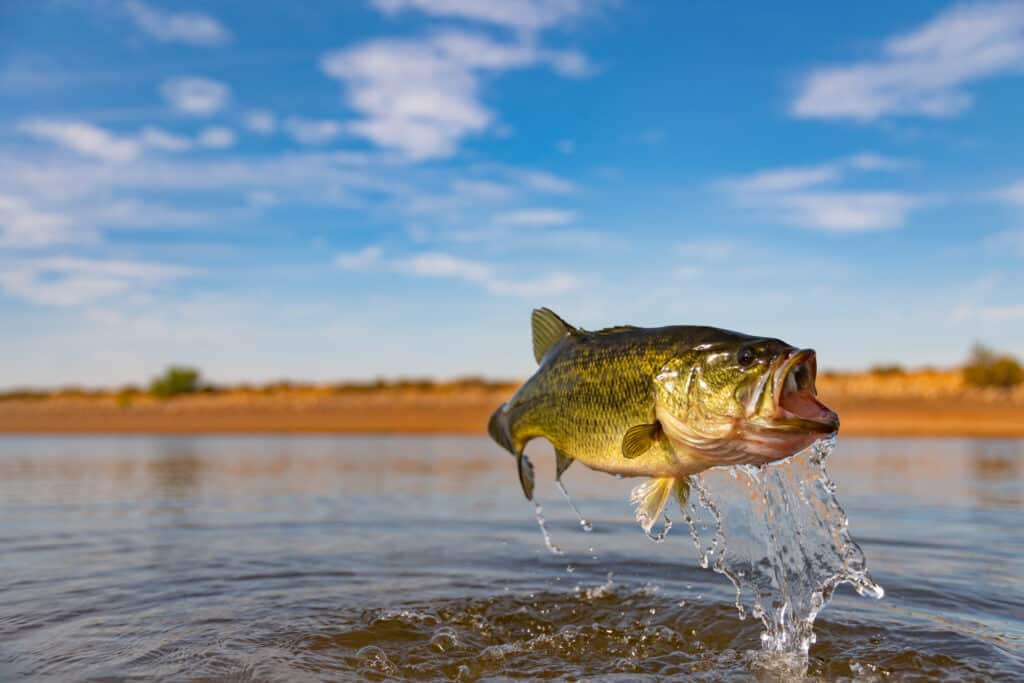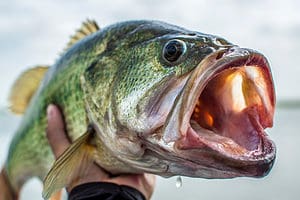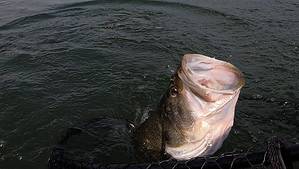The largemouth bass is one of the most sought-after game fish amongst anglers both in North America (where the species is native) as well as other parts of the world where it is now invasive. Strong, feisty, strangely elegant, and absolutely massive, this fish has a long history in the game fishing hobby. This time, we’ll be looking at the largest largemouth bass ever caught in New Mexico, as well as how it compares to the world’s largest specimen. We’ll also touch on some facts about its taxonomy, habitat, average size, and much more below!
The Hardy, Adaptable Largemouth Bass: An Introduction

The largest largemouth bass ever caught in New Mexico weighed over 15 pounds.
©Ryno Botha/Shutterstock.com
In the scientific community, the largemouth bass goes by another name: Micropterus salmoides. Taxonomically, this means it is part of the Micropterus genus. Latin in origin, “Micropterus” translates to “small fin,” while “salmoides” essentially means “resembling a salmon.” To be clear, while the largemouth bass very superficially looks like a salmon and the two share the same geographic range, the species aren’t very closely related.
More commonly known as the black basses, Micropterus is composed of 13 total species. All 13 are native to North America. However, many are now invasive in other parts of the world, like Europe’s Iberian Peninsula and parts of East Asia. Notably, the largemouth is the most widespread, along with the smallmouth bass. It’s also the largest and most prized and sought-after of the black basses within the bass fishing hobby.
Like most black basses, the largemouth is not black in color. Much of its long, narrow yet robust body is a deep, forest green accented by irregular dark brown and yellowish markings, often stripes or splotches. Its underside, meanwhile, is pale gray or white. True to its taxonomic name, its thin, ray-supported fins are rather small compared to its large body size. Still, it manages to be a fearsome predator and swift swimmer. In fact, largemouths are essentially apex predators, as very few species prey upon them once fully grown.
How Big Do Largemouth Bass Get?
While the largemouth bass’ common name is quite fitting as it is, perhaps “largebody bass” would be a more appropriate title! As the largest species out of both its genus and entire taxonomic family, most largemouth specimens measure anywhere from 14 to 20 inches long upon reaching maturity. Meanwhile, most other black basses in the Micropterus genus max out at around 8 to 15 inches when fully grown.
The largemouth isn’t just a lengthy fish, either. It’s also extremely heavy and muscular. Mature specimens can range from 5 to as much as 15 pounds on average. However, especially large individuals, typically breeding females can weigh over 20 pounds! As a sexually dimorphic species, female largemouth basses are larger than males. This is because they often carry tens of thousands of eggs–up to 80,000 at a time–during each spawning season in the spring.
Amazingly, the largemouth’s strong muscles and wide, powerful jaws are capable of taking down prey up to half the size of its entire body! It even uses the same muscles it uses to swim to essentially create a vacuum and suck water and prey into its mouth at high speeds. While it usually feeds on small fish and aquatic invertebrates, it can also resort to swallowing snakes and baby alligators if its preferred prey isn’t available.
The Largemouth’s Important Role in Bass Fishing

The largemouth bass is the most difficult to catch due to its large size.
©Maclane Parker/Shutterstock.com
Although all 13 black bass species have their own unique place in bass fishing, the largemouth bass is arguably the most important to the hobby as a whole. It’s gained a well-deserved reputation as the most challenging to catch due to its size, strength, intelligence, and “fight” when hooked.
This species actually got a humble start in North America in the mid-1800s. Importantly, this was when the steam engine was rapidly expanding the United States’ borders and civilization. As steam engines required a tremendous amount of water to travel across the country, waypoint towns with large tank ponds to fuel them became the most appropriate solution.
Because largemouth bass were resilient enough to withstand long-distance transport–often simply in large buckets–people stocked them in these tank ponds and nearby lakes. As largemouth basses became more widespread and abundant across the US, more anglers took notice. They initially used fly fishing techniques modified from those used to catch species like salmon and trout.
By the early 1900s, anglers all over the US developed their own methods for catching largemouths. Eventually, plastic worm baits became the standard in the 1950s. Thanks to America’s ongoing industrial revolution, plastic had become cheaper and faster to produce than ever. More varying techniques emerged over the following years, including elaborate swimbaits, live baits, and colorful, eye-catching lures.
In 1967, the B.A.S.S. Federation responded to the increasing interest in bass fishing with their first-ever tournament. The Bassmaster Classic followed in 1971. Since then, humans have introduced the species to much of the rest of the world, including South America, much of Europe, parts of east Asia, and even some African countries. Nowadays, bass fishing is more popular than ever–largely thanks to the largemouth’s impact.
What is the Largest Largemouth Bass Ever Caught in New Mexico?
Without further ado, let’s take a look at the largest largemouth bass ever caught in New Mexico, perhaps better known to locals as the Land of Enchantment. As is the case for most other US states, New Mexico’s Department of Game and Fish conveniently tracks state records for most varieties of common game fish. This list, of course, includes the largemouth bass, as well as the angler responsible for the masterful catch.
As you might imagine, the state record is mind-bogglingly impressive. The largest largemouth bass ever caught in New Mexico was a 15-pound, 13-ounce specimen caught by local angler Steve Estrada back in 1995! That’s right–the record has remained unbroken for 28 years and counting. Additionally, the record-breaking fish was 26½ inches long. This is well above the typical range, even for especially large breeding female largemouths.
Notably, Estrada caught this uniquely hefty (and lengthy!) fish at Bill Evans Lake located in the southwestern tip of New Mexico. The lake itself is around 62 acres in size, while the entire park is roughly 300 acres. In addition to being a historic fishing spot, it also boasts a campsite with numerous hiking trails perfect for viewing local wildlife. Many warm-water species like carp and catfish are available year-round, while rainbow trout are active in the winter.
Where Is Bill Evans Lake Located on a Map?
Bill Evans Lake is located west of Mangas Creek and north of Mangas Springs. It also lies to the northeast of Redrock and to the northwest of Silver City.
What is the Largest Largemouth Bass Ever Caught in the World?
Finally, it’s time to look at the world’s largest largemouth bass ever caught and compare it to New Mexico’s best. While Steve Estrada’s record has stood for decades in the Land of Enchantment, it still is around 7 pounds shy of the current world record. Even more fascinatingly, the world record is actually held by two different anglers whose catches are more than 70 years and thousands of miles apart. But how can this be possible?
To be clear, the actual largest specimen ever caught was a 22-pound, 4.97-ounce largemouth bass caught by Japanese angler Manabu Kurita. Kurita caught this one-of-a-kind fish on July 2nd, 2009 at Lake Biwa in Japan’s Shiga Prefecture. Lake Biwa is a historic fishing spot–one of the oldest in the world, in fact–and even today it houses a thriving range of game fish and other wildlife. The largemouth bass was introduced to Japan sometime in the 1920s.
However, due to an International Game Fish Association rule that requires new fishing records to be at least two ounces larger than the previous record, Kurita shares his record with the late American angler George W. Perry. On June 2nd, 1932, Perry caught a 22-pound, 4-ounce largemouth bass at Georgia’s Lake Montgomery. Since Kurita’s bass only outweighs Perry’s by around an ounce, they both share the world record.
The photo featured at the top of this post is © Pierre Rebollar/Shutterstock.com
Thank you for reading! Have some feedback for us? Contact the AZ Animals editorial team.






